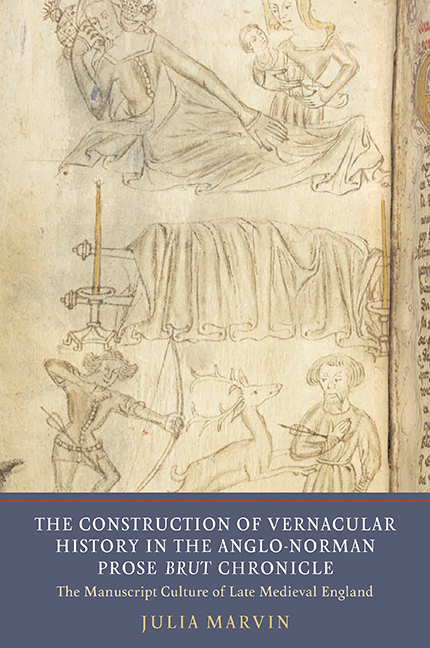 The Construction of Vernacular History in the Anglo-Norman Prose Brut Chronicle
The Construction of Vernacular History in the Anglo-Norman Prose Brut Chronicle Book contents
- Frontmatter
- Dedication
- Content
- List of Plates
- Acknowledgments
- Abbreviations
- A Note on Proper Names, Transcriptions, and Translations
- Introduction: Recognizing the Prose Brut Tradition
- Part I Construction
- 1 A New New Troy: Brut, Rome, and the Foundations of British History
- 2 The Community of the Realm: King, Baron, Brother, Stranger
- 3 Women with Voices
- 4 Social Arthur
- 5 The Continuity of the Realm
- Part II Reconstruction and Response
- Conclusion: Merlin's Power
- Bibliography
- General Index
- Index of Manuscripts Cited
1 - A New New Troy: Brut, Rome, and the Foundations of British History
from Part I - Construction
Published online by Cambridge University Press: 01 February 2018
- Frontmatter
- Dedication
- Content
- List of Plates
- Acknowledgments
- Abbreviations
- A Note on Proper Names, Transcriptions, and Translations
- Introduction: Recognizing the Prose Brut Tradition
- Part I Construction
- 1 A New New Troy: Brut, Rome, and the Foundations of British History
- 2 The Community of the Realm: King, Baron, Brother, Stranger
- 3 Women with Voices
- 4 Social Arthur
- 5 The Continuity of the Realm
- Part II Reconstruction and Response
- Conclusion: Merlin's Power
- Bibliography
- General Index
- Index of Manuscripts Cited
Summary
The narrative of the Oldest Version of the prose Brut chronicle is built of kings’ reigns laid end to end. With over a hundred rulers to cover, it goes into detail only on the most prominent and most recent. Aside from a handful of notables, the earlier kings generally make do with a few sentences, brief descriptions stripped down even from Wace, who in turn generally condenses Geoffrey.
A typical stretch on the lives of some lesser-known British kings in the years between Brut and Arthur:
[Del Roy Guentholen, homme bien entecche.
Apres la mort cest Goryn Batruz regna sun fyz Guentholen, bien entecche, e bien gouerna la tere e sagement. E regna taunt cum deu voleyt e pus morust.
Del Roy Seysyl, home de bon manere.
Apres cesti Guentholon regna sun fyz Seysyl. Bien e noblement gouerna la tere e sagement, cum sun pere auoyt fet deuaunt ly, e donke regna taunt cum deu voleyt e pus morut.
Del Roy Kymor.
[A]pres cesty Seysyl regna sun fyz Kymor, home de bone manere, mes il ne regna mye lo<n>gement.
Del Roy Hohan, coment il gouerna sa tere noblement.
Apres cesti Kymor regna sun fyz Hohan bien e noblement.]
Coment le Roi Morwith morut sudeinement.
Apres la mort cesti [Hohan] regna son fiz Morwith, e deuint si cruel homme e si maluois qe graunt mescheaunce li auenist au darein. Qar sicome il ala vn iour prede la cost de la mer, il encountrast vne beste grant, noir, e hidous, e quida qil vst este vne cete de la mer. E tendi son alblast e le voleit auer tue dun quarel, mes il nel poeit ferir. E quant il auoit tret tuz ses quareus e pur nent, la beste vint a li graunt espleite e li deuora tut vif si li emporta. E issint morust cesti roi par vengeaunce deu pur sa mauueiste.
(‘Of King Guentholen, a worthy man.
After the death of this Gorin Batruz reigned his worthy son Guentholen, and he governed the land well and wisely. And he reigned as long as Godwilled, and then he died.
Of King Seysyl, a man of good conduct.
After this Guentholen reigned his son Seysyl. He governed the land well and nobly and wisely, as his father had done before him, and so he reigned as long as God willed, and then he died.
- Type
- Chapter
- Information
- The Construction of Vernacular History in the Anglo-Norman Prose Brut ChronicleThe Manuscript Culture of Late Medieval England, pp. 21 - 56Publisher: Boydell & BrewerPrint publication year: 2017
